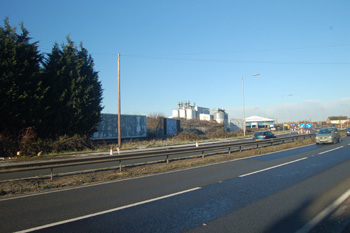The Dun Cow Beerhouse Girtford

The site of the Dun Cow Beerhouse lies approximately at the unused advertising hoardings centre of shot
The Dun Cow Beerhouse: west side of London Road, Girtford
Not very much information about the Dun Cow Beerhouse survives. It is referred to in licensing registers and the names of the tenants can be traced in directories as beer sellers in Girtford.
The countywide register of alehouse licences of 1876, when the Dun Cow was owned by Simpson’s Baldock Brewery states that the building was first licensed in 1860. The countywide register of alehouse licences of 1903 reveals that the nearest licensed house was 34 yards away (the Swan Beerhouse at 114 London Road), that the state of repair of the Dun Cow was good and that it had one front door.
This last piece of information enables us to have a reasonable guess at the location of the Dun Cow. Measuring about thirty yards north-west of the White Swan on the opposite, west side, of the Great North Road (A1) brings us to a property which has since been demolished.
It stood opposite 140 London Road and the 1910 Domesday Survey confirms that this was the place. David Lloyd-George's pioneering 1909 budget, in many ways the beginning of social welfare in this country, needed money to pay for his reforms. One of the ways to raise funds was to increase rates and to do this a survey of all property in the country was needed. This survey, carried out in 1910, was the most detailed land ownership survey since the Domesday Book of 1086 and the survey was thus known colloquially as the 1910 Domesday Survey.
The Rating and Valuation Act 1925 specified that every building and piece of land in the country was to be assessed to determine its rateable value. Sandy, like most Bedfordshire parishes was assessed in 1927. The valuer visiting this now demolished building notes that it was owned by Louisa Brice and occupied by G. J. Brice. As the last known tenant of the Dun Cow, in 1914, was George James Brice it suggests that this private house is the former beerhouse. Naturally this can only be a tentative judgement – there may have been two G. J. Brices or the former landlord may have moved to another premises but the coincidence is suggestive. Presumably, if this guess is correct, Louisa Brice bought the property from Simpson's Brewery after the beerhouse closed around the time of World War One.
This house, in 1927, was built of brick, lath, plaster and tiles and comprised a living room, kitchen and scullery with two bedrooms and a box room above. Outside stood a w. c., four tile and corrugated iron sheds and an open shed. The valuer commented: “Old House”, “Rather Nice” and “Rent very low”. Sadly the rather nice old house was demolished at some point between 1927 and 1972 when an Ordnance Survey map simply shows a space where it had been.
References:
- HF143/1: Register of Alehouse Licences - Biggleswade Petty Sessional Division: 1872-1873;
- HF143/2: Register of Alehouse Licences - Biggleswade Petty Sessional Division: 1874-1877;
- HF143/3: Register of Alehouse Licences - Biggleswade Petty Sessional Division: 1878-1881;
- HF143/4: Register of Alehouse Licences - Biggleswade Petty Sessional Division: 1882-1890;
- HF143/5: Register of Alehouse Licences - Biggleswade Petty Sessional Division: 1891-1900;
- HF143/6: Register of Alehouse Licences - Biggleswade Petty Sessional Division: 1900-1914;
- PSBW8/1: Register of Alehouse Licences - Biggleswade Petty Sessional Division: 1903-1915.
List of Licensees: note that this is not a complete list. Italics indicate licensees whose beginning and/or end dates are not known:
1869-1872: Charles Robarts;
1872-1882: Charles Jeeves;
1882-1889: Elijah Fage;
1889-1907: Frederick Ball junior;
1907-1910: William Emery;
1910-1913: Jane Cummings;
1913-1914: George James Brice.
Beerhouse closed between 1914 and 1920.